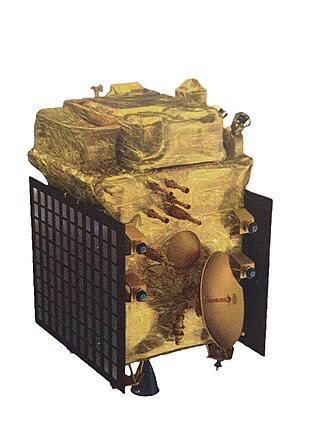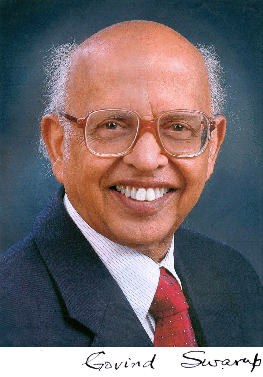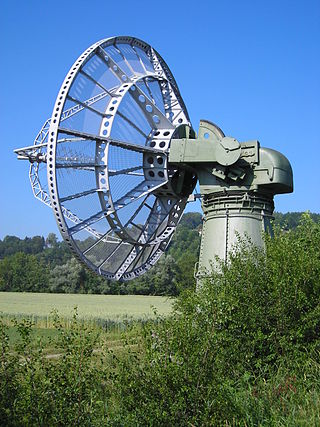
X-ray astronomy is an observational branch of astronomy which deals with the study of X-ray observation and detection from astronomical objects. X-radiation is absorbed by the Earth's atmosphere, so instruments to detect X-rays must be taken to high altitude by balloons, sounding rockets, and satellites. X-ray astronomy uses a type of space telescope that can see x-ray radiation which standard optical telescopes, such as the Mauna Kea Observatories, cannot.

Astronomy is a natural science that studies celestial objects and phenomena. It uses mathematics, physics, and chemistry in order to explain their origin and evolution. Objects of interest include planets, moons, stars, nebulae, galaxies, meteoroid, asteroid, and comets. Relevant phenomena include supernova explosions, gamma ray bursts, quasars, blazars, pulsars, and cosmic microwave background radiation. More generally, astronomy studies everything that originates beyond Earth's atmosphere. Cosmology is a branch of astronomy that studies the universe as a whole.

A solar flare is an intense localized eruption of electromagnetic radiation in the Sun's atmosphere. Flares occur in active regions and are often, but not always, accompanied by coronal mass ejections, solar particle events, and other solar phenomena. The occurrence of solar flares varies with the 11-year solar cycle.

A coronal mass ejection (CME) is a significant ejection of magnetic field and accompanying plasma mass from the Sun's corona into the heliosphere. CMEs are often associated with solar flares and other forms of solar activity, but a broadly accepted theoretical understanding of these relationships has not been established.

Jan Hendrik Oort was a Dutch astronomer who made significant contributions to the understanding of the Milky Way and who was a pioneer in the field of radio astronomy. The New York Times called him "one of the century's foremost explorers of the universe"; the European Space Agency website describes him as "one of the greatest astronomers of the 20th century" and states that he "revolutionised astronomy through his ground-breaking discoveries." In 1955, Oort's name appeared in Life magazine's list of the 100 most famous living people. He has been described as "putting the Netherlands in the forefront of postwar astronomy."

Didier Patrick Queloz is a Swiss astronomer. He is the Jacksonian Professor of Natural Philosophy at the University of Cambridge, where he is also a fellow of Trinity College, Cambridge, as well as a professor at the University of Geneva. Together with Michel Mayor in 1995, he discovered 51 Pegasi b, the first extrasolar planet orbiting a Sun-like star, 51 Pegasi. For this discovery, he shared the 2019 Nobel Prize in Physics with Mayor and Jim Peebles. In 2021, he was announced as the founding director of the Center for the Origin and Prevalence of Life at ETH Zurich.

AD Leonis (Gliese 388) is a red dwarf star. It is located relatively near the Sun, at a distance of 16.2 light-years, in the constellation Leo. AD Leonis is a main sequence star with a spectral classification of M3.5V. It is a flare star that undergoes random increases in luminosity.
Bernard Haisch is a German-born American astrophysicist who has done research in solar-stellar astrophysics and stochastic electrodynamics. He has developed with Alfonso Rueda a speculative theory that the non-zero lowest energy state of the vacuum, as predicted by quantum mechanics, might provide a physical explanation for the origin of inertia, and might someday be used for spacecraft propulsion. Haisch has advocated the serious scientific study of phenomena outside the traditional scope of science and is known for his interest in the UFO phenomenon as well as a variety of other unorthodox topics.
Dame Carole Jordan,, is a British physicist, astrophysicist, astronomer and academic. Currently, she is Professor Emeritus of Astrophysics at the University of Oxford and Emeritus Fellow at Somerville College, Oxford. From 1994 to 1996, she was President of the Royal Astronomical Society; she was the first woman to hold this appointment. She won the Gold Medal of the Royal Astronomical Society in 2005; she was only the third female recipient following Caroline Herschel in 1828 and Vera Rubin in 1996. She was head of the Rudolf Peierls Centre for Theoretical Physics at the University of Oxford from 2003 to 2004 and 2005 to 2008, and was one of the first female professors in Astronomy in Britain. She was made a Dame Commander of the Order of the British Empire in 2006 for services to physics and astronomy.

II Pegasi is a binary star system in the constellation of Pegasus with an apparent magnitude of 7.4 and a distance of 130 light-years. It is a very active RS Canum Venaticorum variable, a close binary system with active starspots.

Aditya L1 is a planned coronagraphy spacecraft to study solar atmosphere, currently being designed and developed by the Indian Space Research Organisation (ISRO) and various other Indian research institutes. It will be inserted in a halo orbit around the L1 point between the Earth and the Sun where it will study the solar atmosphere, solar magnetic storms and its impact on environment around Earth.

Govind Swarup was a pioneer in radio astronomy. In addition to research contributions in multiple areas of astronomy and astrophysics, he was a driving force behind the building of "ingenious, innovative and powerful observational facilities for front-line research in radio astronomy".

The Astronomical Institute of the Czech Academy of Sciences is a scientific institute headquartered at the Ondřejov Observatory, roughly 35 km southeast of Prague, Czech Republic.

Louise Harra is a Northern Irish physicist, born in Lurgan, County Armagh, Northern Ireland. She is the Director of the World Radiation Centre of the Physical Meteorological Observatory in Davos (PMOD/WRC) and affiliated professor at the Institute of Particle Physics and Astrophysics of ETH Zurich.

Bleien Radio Observatory is a radio astronomy observatory located halfway between Zurich and Bern in Switzerland. Its focus is on large bandwidth radio spectroscopy. The observatory is near the village of Bleien, 5 km south of Gränichen in the Canton of Aargau. The place is in a shallow valley that is relatively well protected against terrestrial interference.

The Community of European Solar Radio Astronomers (CESRA) is a non-profit informal organization of European scientists whose aims are to promote studies of solar radio physics and related topics.
Philippa K. Browning is a Professor of Astrophysics in the Jodrell Bank Centre for Astrophysics at the University of Manchester. She specialises in the mathematical modelling of fusion plasmas.
Lyndsay Fletcher is a Scottish astrophysicist at the University of Glasgow who specialises in solar flares.
Solar radio emission refers to radio waves that are naturally produced by the Sun, primarily from the lower and upper layers of the atmosphere called the chromosphere and corona, respectively. The Sun produces radio emissions through four known mechanisms, each of which operates primarily by converting the energy of moving electrons into electromagnetic radiation. The four emission mechanisms are thermal bremsstrahlung (braking) emission, gyromagnetic emission, plasma emission, and electron-cyclotron maser emission. The first two are incoherent mechanisms, which means that they are the summation of radiation generated independently by many individual particles. These mechanisms are primarily responsible for the persistent "background" emissions that slowly vary as structures in the atmosphere evolve. The latter two processes are coherent mechanisms, which refers to special cases where radiation is efficiently produced at a particular set of frequencies. Coherent mechanisms can produce much larger brightness temperatures (intensities) and are primarily responsible for the intense spikes of radiation called solar radio bursts, which are byproducts of the same processes that lead to other forms of solar activity like solar flares and coronal mass ejections.
Gordon Dean Holman is an emeritus research astrophysicist at the National Aeronautics and Space Administration’s (NASA’s) Goddard Space Flight Center in Greenbelt, Maryland. His research mostly focused on obtaining an understanding of high-energy radiation from astronomical objects. This radiation cannot be observed from Earth’s surface, but is observed with instruments on satellites launched to orbits above Earth’s atmosphere. It is primarily emitted by high-energy electrons interacting with ions. These electrons also emit radiation at radio frequencies which is observed from Earth’s surface. Consequently, these observations from space and radio telescopes provide a view of hot gas and energetic particles in the Universe that could not otherwise be obtained. Holman has specialized in the interpretation of these observed emissions to determine the origin and evolution of this hot gas and energetic particles. He has been described as "not just a theorist, he also looks at the data".














